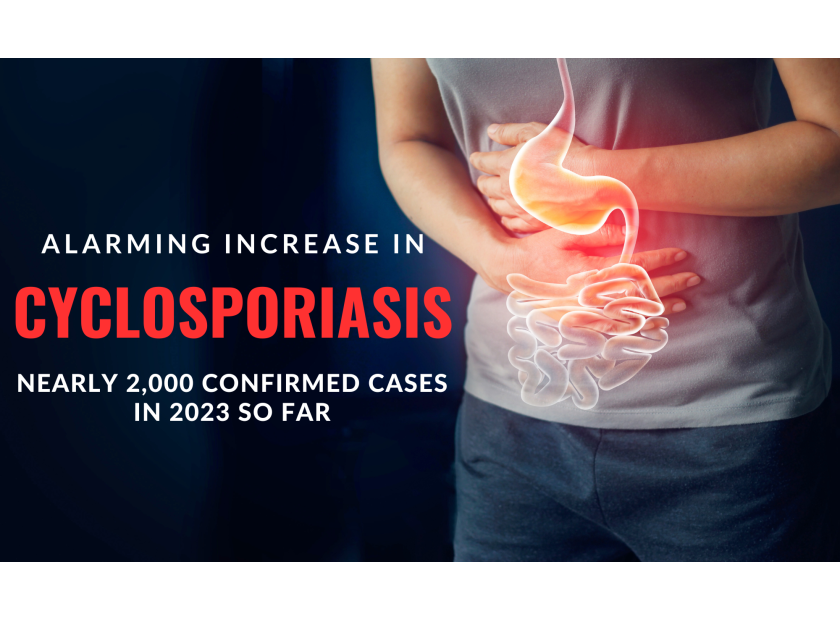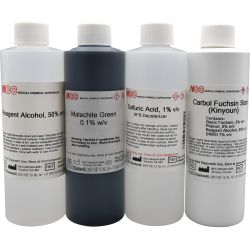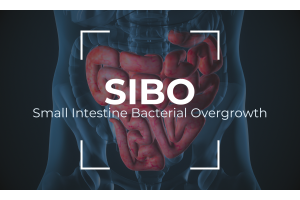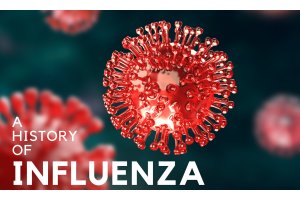Alarming increase in Cyclospora cases in the US
A total of 1,957 laboratory-confirmed cases of cyclosporiasis have been reported in the United States so far this year.
That is already surpassing the 1,129 cases reported in all of 2022. (1) The investigation of this outbreak is ongoing with no specific food item being identified as the source of most of these illnesses, although the outbreak count does include 20 patients in Georgia and Alabama whose infections were found to be linked to raw imported broccoli. The broccoli outbreak appears to be over and there is no indication that broccoli continues to be a source of illness for the other cyclosporiasis cases. (1) Other common sources include cilantro, raspberries, and basil. Sick people range in age from 2 to 96 years with a median age of 50 and 58% are female. 153 hospitalizations and zero deaths have been recorded.
What is cyclosporiasis?
Cyclospora cayetanensis is a parasite that causes intestinal infection. The parasite is spread by consuming food or water that was contaminated with feces containing the sporulated oocysts of the parasite. It can only be spread through human waste and not directly from person to person. (2) This is because an infected person sheds unsporulated oocysts (which are not infective) and it takes 1-2 weeks in a favorable environment outside of the body for the oocysts to sporulate and become infective. The black and white photo to the right shows a sporulating oocyst containing two immature sporocysts. No animal reservoirs of Cyclospora cayetanensis have been identified.
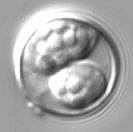
What are the symptoms of cyclosporiasis?
The incubation time is usually about one week, and symptoms include watery diarrhea with frequent bowel movements, loss of appetite, weight loss, stomach cramps/pain, bloating, increased gas, nausea, and fatigue. (3) While symptoms can be severe enough to require hospitalization, death from cyclosporiasis is rare.
How is cyclosporiasis diagnosed and treated?
Laboratory diagnosis is done through microscopy using a modified acid fast stain (organisms will stain pink to deep red or purple, see color photo to right) or PCR. The organisms will auto-fluoresce under a UV fluorescent microscope.
Cyclospora infections are treated with trimethoprim-sulfamethoxazole (brand name: Bactrim, Septra, Cotrim).
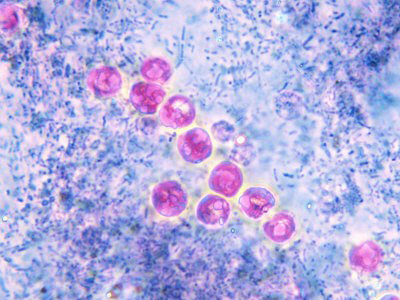
Where is cyclosporiasis most common?
Cyclosporiasis occurs in many countries and seems to be most common in tropical and subtropical regions. The risk for infection is typically seasonal but no consistent pattern has been identified regarding time of year or environmental conditions. In the United States, outbreaks have been linked to various types of imported fresh produce. Other cases have occurred in persons who traveled to Cyclospora-endemic areas. (4)
What is the best way to prevent cyclosporiasis?
The best way to prevent Cyclospora infections is to follow safe fruit and vegetable handling recommendations and to avoid food or water that may have been contaminated with feces. Travelers to cyclosporiasis-endemic areas should be aware that treatment of water or food by routine chemical disinfection or sanitizing methods is unlikely to kill Cyclospora. No vaccine for cyclosporiasis is available (5).
By Alani Vasquez
R&D Manager, Hardy Diagnostics
Meet the author

R&D MANAGER at HARDY DIAGNOSTICS
Alani Vasquez
Alani Vasquez received her B.S. in Microbiology from Cal Poly San Luis Obispo. She began working for Hardy Diagnostics in 2014 as an R&D Technician working on new culture media formulations. Alani now manages R&D projects and strives to build a team of innovative thinkers and problem solvers. As the manager of R&D, her goal is to carve a future for Hardy Diagnostics through innovation and technology. In her spare time, Alani enjoys spending time in her garden, making sourdough bread, and caring for her many animals including chickens, dogs, and a cat.


